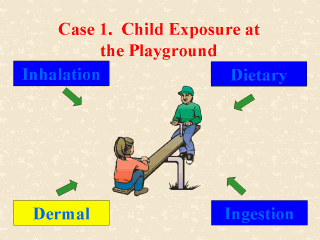| front |1 |2 |3 |4 |5 |6 |7 |8 |9 |10 |11 |12 |13 |14 |15 |16 |17 |18 |19 |20 |21 |22 |23 |24 |review |
 |
The basic
algorithm for calculation of dermal exposure is: [dermal uptake] = [surface
concentration] x [acquisition rate] x [exposure duration]. In this case
study, the dermal dose potentially could come from three or four surface sources
including: (a) the wood preservative residues in soil or sandbox around the treated
playground structures; (b) the residues left on the treated structures; (c) the residues
in the shower or bath water; and (d) the residues on structures inside or outside of the
home or other places (e.g., school). A wood preservative like arsenic can be found in drinking water, ambient air, food, cigarette smoking, and hence potentially many structural surfaces in even untreated homes or schools. However, in practice the last two sources listed above are excluded from consideration due to their low levels involved. For dermal uptake from treated surface, the residues are often measured as surface dislodgeables whereas the acquisition rate, as hourly dermal transfer rate for the entire body or for a major body region. Surface dislodgeables are often defined as those that can be wiped off or extracted off with a solution. A dermal transfer rate is the amount of surface residues anticipated to be transferred onto the body skin per unit of surface level. This transferability is not only presumably a function of surface level (e.g., m g/hour of dermal residues per m g/cm2 of surface residues), but also highly activity-dependent. For dermal uptake from soil, the acquisition rate is often measured in terms of skin-soil loading per event, and is a function of the body surface involved (e.g., mg soil/cm2 of skin surface/day). |